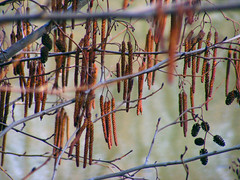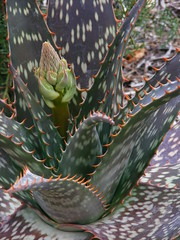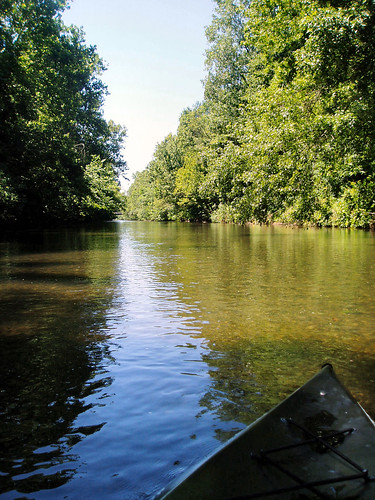I imagine even non-birders have to take note of the Riverwalk's resident grackles. They are large, noisy, brash, gregarious and at least at this time of year, have a night roost in the trees around the Riverwalk. They go by the common name of Great-Tailed Grackle and it's apt, given the way the males fan their long tails and flourish them in an attempt to impress a female grackle. When they're not busy wooing, they stroll about snatching fallen tortilla chips. The grackles have an impressive array of vocalizations and at night when they are settling down for bed it is a veritable cacophony in the trees above.
There are also large numbers of white-winged doves, pigeons, mallards and house sparrows living off the leavings of huge numbers of tourists. The umbrellas which shade nearly every outdoor table along the Riverwalk are not just there to protect from sun and rain. I'm by no means a germ-phobe, but I'm quite glad I packed a purse-size bottle of hand sanitizer on this trip. Every unprotected outdoor surface bears evidence of the abundance of bird life in the area.
Here's a ten second video of a male great-tailed grackle bathing in a fountain at the San Antonio Botanical Garden:
Friday, March 28, 2008
San Antonio's Riverwalk
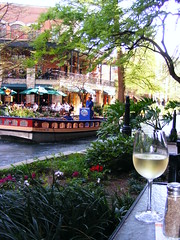 San Antonio's Riverwalk is a tourist attraction done right. Descending a flight of stairs from street level leads you into two and a half mile series of pathways that border the small green San Antonio River, which is plied by flatboats filled with laughing people. There are only two methods of transportation on the Riverwalk - your feet and the boats. The Riverwalk is lined with more restaurants and hotels than I could count, interspersed with splashing fountains, arched foot bridges and ancient bald cyprus trees. The Riverwalk is also famous for its music scene and there is no shortage of places to kick back with a cocktail while listening to live jazz.
San Antonio's Riverwalk is a tourist attraction done right. Descending a flight of stairs from street level leads you into two and a half mile series of pathways that border the small green San Antonio River, which is plied by flatboats filled with laughing people. There are only two methods of transportation on the Riverwalk - your feet and the boats. The Riverwalk is lined with more restaurants and hotels than I could count, interspersed with splashing fountains, arched foot bridges and ancient bald cyprus trees. The Riverwalk is also famous for its music scene and there is no shortage of places to kick back with a cocktail while listening to live jazz. The Riverwalk was designed by a young architect by the name of Robert H.H. Hugman in 1929. His plan was not put into action until 1939 however, when the WPA undertook construction. It was completed only two years later, concluding with the first annual Fiesta River Parade, featuring floats that actually float.
Labels:
"San Antonio",
history,
Riverwalk,
Texas,
travel
Tuesday, March 25, 2008
Bad blogger
 I've been terribly remiss at updating my blog the past couple of days. I can only blame the fact that I'm getting ready to go out of town for a few days. That and the fact that my brother came into town from Atlanta and we've been hanging out. We took the kids down to the Cincinnati Museum Center today to see the BODIES exhibit, which was both fascinating and gruesome. Then there was a quick trip to the Carew Tower and after that on to the Knotty Pine on the Bayou for dinner. This time tomorrow night I should be in San Antonio.
I've been terribly remiss at updating my blog the past couple of days. I can only blame the fact that I'm getting ready to go out of town for a few days. That and the fact that my brother came into town from Atlanta and we've been hanging out. We took the kids down to the Cincinnati Museum Center today to see the BODIES exhibit, which was both fascinating and gruesome. Then there was a quick trip to the Carew Tower and after that on to the Knotty Pine on the Bayou for dinner. This time tomorrow night I should be in San Antonio.
Labels:
bodies,
Cincinnati,
exhibits,
life as I know it,
Museum Center,
Ohio,
travel
Saturday, March 22, 2008
Eggs!
 Eggs are one of the oldest fertility symbols around and of course, closely associated with this season of Spring and the Christian Easter holiday. Here are a number of unspeakable things to do to eggs what never did you no harm. OK, the tea eggs aren't unspeakable; they're really quite tasty (because they don't taste of tea, just eggy goodness).
Eggs are one of the oldest fertility symbols around and of course, closely associated with this season of Spring and the Christian Easter holiday. Here are a number of unspeakable things to do to eggs what never did you no harm. OK, the tea eggs aren't unspeakable; they're really quite tasty (because they don't taste of tea, just eggy goodness).Chinese Tea Eggs
Tie-Dye Easter Eggs
Transparent Bouncy Egg
Batik Eggs
Egg in a Bottle
Naturally Dyed Easter Eggs
Washi Eggs

Thursday, March 20, 2008
I just love stuff like this
The PocketMod is a little eight-page booklet for you to customize, print and fold. I just made one for my up-coming San Antonio trip that includes my emergency contact information, flight schedules, hotel name and number, plus a couple of lined pages for taking notes, a couple of pages of check book register to keep track of my finances, and a sudoku game. The software isn't without its glitches just yet; the text I entered into the blank custom page showed up on screen but didn't print and I had to use a work-around. Still, I'm going to keep a close eye on it; it's useful as can be. I'd recommend using CutePDF to print to a file so you can double check your print-out before wasting paper.
By way of LifeHacker.
Wednesday, March 19, 2008
Why I didn't go to the gym today...
Mother Nature decided a blizzard in March wasn't enough, so she's sent somewhere between four and six inches of rain our way. It's still raining right this minute. Both the Little and Great Miami are well above flood stage, as are any number of smaller rivers and creeks in the area. My gym is in Sharonville but two roads I have to traverse to get there were completely closed (Kemper and Main) due to high water so I came home and worked out to a video instead.
We can have spring now, yes?
Labels:
Cincinnati,
flood,
flooding,
life as I know it,
Ohio,
Sharonville,
weather
Monday, March 17, 2008
Counting Coots
 I photographed this lone coot at Sharon Wood's lake last week, which inspired me to learn a bit more about this odd rail. I found a report on a scientific study which suggests that coots can count, at least as far as the number of eggs in their own nest goes. Coots, like many other species of birds, practice a behavior known as brood parasitism. This involves a gravid female sneaking onto an unguarded but active nest and laying an egg within, leaving the owner of the nest to raise the sneak's offspring. Since this might be detrimental to the victim's own offspring, there is constant pressure to recognize that the parasitism has taken place and to counteract it afterwards. Coots apparently do this by counting the eggs in their nest once they are finished laying and rejecting any that appear later. They may push the offending egg out of the nest, bury it deep in the nest material where they will never hatch, or relegate it to the periphery of the nest where it will have a diminished chance of hatching.
I photographed this lone coot at Sharon Wood's lake last week, which inspired me to learn a bit more about this odd rail. I found a report on a scientific study which suggests that coots can count, at least as far as the number of eggs in their own nest goes. Coots, like many other species of birds, practice a behavior known as brood parasitism. This involves a gravid female sneaking onto an unguarded but active nest and laying an egg within, leaving the owner of the nest to raise the sneak's offspring. Since this might be detrimental to the victim's own offspring, there is constant pressure to recognize that the parasitism has taken place and to counteract it afterwards. Coots apparently do this by counting the eggs in their nest once they are finished laying and rejecting any that appear later. They may push the offending egg out of the nest, bury it deep in the nest material where they will never hatch, or relegate it to the periphery of the nest where it will have a diminished chance of hatching.I've come to expect brilliant behavior from birds like the crows and the parrots, but counting ability from a coot astounded me. They are somewhat comical birds and have been likened to a water-going pigeon due to their habit of pumping their head back and forth when they swim, much as pigeons do when walking.
Sunday, March 16, 2008
Hiking the Shaker Trace Loop
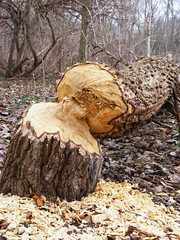 Today I walked the long loop (7.8 miles) of the Shaker Trace trail at Miami-Whitewater Forest. It's not my favorite path; long stretches of it pass through miles of corn fields, which make for rather dull walking. It has the advantage of being paved, however. Between the melting snow from last week's blizzard and the following rain, I thought I would be ankle deep in mud on most of my favorite trails. There were just loads of birds making themselves known today and it made the walk enjoyable; there's a list of what I saw (or heard) below, haphazardly ordered. Still, I was quite footsore by the end; walking on pavement tires me out much more than walking on dirt and leaves.
Today I walked the long loop (7.8 miles) of the Shaker Trace trail at Miami-Whitewater Forest. It's not my favorite path; long stretches of it pass through miles of corn fields, which make for rather dull walking. It has the advantage of being paved, however. Between the melting snow from last week's blizzard and the following rain, I thought I would be ankle deep in mud on most of my favorite trails. There were just loads of birds making themselves known today and it made the walk enjoyable; there's a list of what I saw (or heard) below, haphazardly ordered. Still, I was quite footsore by the end; walking on pavement tires me out much more than walking on dirt and leaves.I spotted the pictured large tree obviously felled by a beaver along the Dry Fork Creek. Extirpated from Ohio by 1830, beavers started making their way back into Ohio in the 1940s and have been expanding their range ever since. The range map on this page doesn't even show Hamilton County as confirmed for an active beaver population, but I suspect is is simply out of date. I saw signs of a beaver family living in this area ten years ago.
On a different note, one of my favorite authors was in the news these past couple of days for having donated a million dollars to Alzheimer's research. Terry Pratchett was recently diagnosed with early onset Alzheimer's disease himself. His legions of fans have started a campaign to match Terry's donation called Match It For Pratchett. There you will find links to donate directly to the Alzheimer's Trust or you can buy a t-shirt, decorated with elephants and the Great A'Tuin. It's a worthy cause even if you're not a Pratchett fan. If you've not read any of his work, you should do so; he's brilliantly funny.

Belted Kingfisher, Eastern Phoebe, American Crow, Blue Jay, Song Sparrow, Carolina Wren, Carolina Chickadee, Tufted Titmouse, Mallard, Canada Goose, Cooper's Hawk, Killdeer, Red-Winged Blackbird, Red-Tailed Hawk, Kestrel, Wild Turkey, Grackle, Turkey Vulture, Rufus-Sided Towhee, Eastern Bluebird, White-Throated Sparrow, Downy Woodpecker, Red-Bellied Woodpecker, Pileated Woodpecker
Labels:
Alzheimer's,
birding,
birds,
books,
Cincinnati,
hiking,
life as I know it,
nature,
Ohio,
Terry Pratchett
Friday, March 14, 2008
Happy Pi Day!
 On March 14th, math geeks around the world celebrate the beauty of Pi by eating pie and toasting the birthday of Albert Einstein. The Exploratorium gave rise to Pi Day some twenty years ago and the holiday continues to grow in popularity with each passing year. You can gaze in Zen-like wonder at Pi calculated to one million digits or marvel over Pi-Ku. Or you could just eat some pie, be it apple, pizza or shepherd's.
On March 14th, math geeks around the world celebrate the beauty of Pi by eating pie and toasting the birthday of Albert Einstein. The Exploratorium gave rise to Pi Day some twenty years ago and the holiday continues to grow in popularity with each passing year. You can gaze in Zen-like wonder at Pi calculated to one million digits or marvel over Pi-Ku. Or you could just eat some pie, be it apple, pizza or shepherd's.
Thursday, March 13, 2008
Alder Catkins
Somehow I managed to walk four and a half miles today - a workday no less. The weather was sunny and in the sixties and I couldn't stay inside. I spent my two breaks during the day doing laps around the office building (five laps equals one mile) and after work I went over to Sharon Woods and walked all the way around Sharon Lake.
There are many alder trees bordering the lake and they are already in bloom. This photo depicts long catkins, which are the male flowers of this tree. You can also see the woody remains of the female catkins from last year, still clinging to the tree. They look like tiny pine cones.
Alder trees are water loving and their oily wood is found throughout Venice, Italy in underwater foundations and pilings. It was also commonly used to build bridges. The wood does not rot in water, instead becoming hard as stone. Alder trees are also very useful in environmental reclamation projects, as the nitrogen fixing nodules on their root system improve soil fertility.
There are many alder trees bordering the lake and they are already in bloom. This photo depicts long catkins, which are the male flowers of this tree. You can also see the woody remains of the female catkins from last year, still clinging to the tree. They look like tiny pine cones.
Alder trees are water loving and their oily wood is found throughout Venice, Italy in underwater foundations and pilings. It was also commonly used to build bridges. The wood does not rot in water, instead becoming hard as stone. Alder trees are also very useful in environmental reclamation projects, as the nitrogen fixing nodules on their root system improve soil fertility.
Labels:
Cincinnati,
hiking,
history,
identification,
life as I know it,
local,
nature,
Ohio,
trees
Subscribe to:
Posts (Atom)
